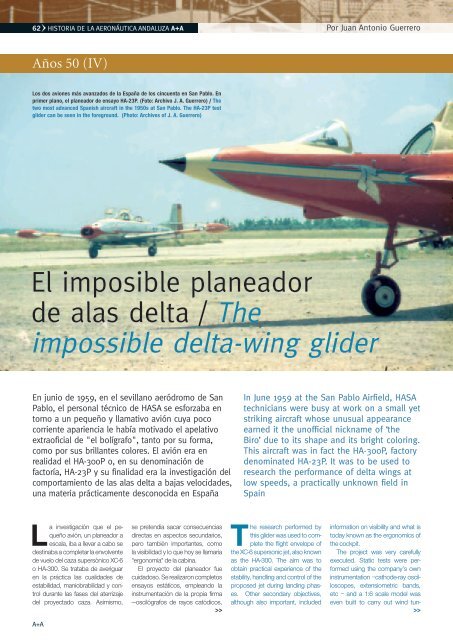El cluster aeroespacial - Helice Foundation
El cluster aeroespacial - Helice Foundation
El cluster aeroespacial - Helice Foundation
You also want an ePaper? Increase the reach of your titles
YUMPU automatically turns print PDFs into web optimized ePapers that Google loves.
62 HISTORIA DE LA AERONÁUTICA ANDALUZA A+A<br />
Años 50 (IV)<br />
Los dos aviones más avanzados de la España de los cincuenta en San Pablo. En<br />
primer plano, el planeador de ensayo HA-23P. (Foto: Archivo J. A. Guerrero) / The<br />
two most advanced Spanish aircraft in the 1950s at San Pablo. The HA-23P test<br />
glider can be seen in the foreground. (Photo: Archives of J. A. Guerrero)<br />
En junio de 1959, en el sevillano aeródromo de San<br />
Pablo, el personal técnico de HASA se esforzaba en<br />
torno a un pequeño y llamativo avión cuya poco<br />
corriente apariencia le había motivado el apelativo<br />
extraoficial de "el bolígrafo", tanto por su forma,<br />
como por sus brillantes colores. <strong>El</strong> avión era en<br />
realidad el HA-300P o, en su denominación de<br />
factoría, HA-23P y su finalidad era la investigación del<br />
comportamiento de las alas delta a bajas velocidades,<br />
una materia prácticamente desconocida en España<br />
A+A<br />
Por Juan Antonio Guerrero<br />
<strong>El</strong> imposible planeador<br />
de alas delta / The<br />
impossible delta-wing glider<br />
La investigación que el pequeño<br />
avión, un planeador a<br />
escala, iba a llevar a cabo se<br />
destinaba a completar la envolvente<br />
de vuelo del caza supersónico XC-6<br />
o HA-300. Se trataba de averiguar<br />
en la práctica las cualidades de<br />
estabilidad, maniobrabilidad y control<br />
durante las fases del aterrizaje<br />
del proyectado caza. Asimismo,<br />
se pretendía sacar consecuencias<br />
directas en aspectos secundarios,<br />
pero también importantes, como<br />
la visibilidad y lo que hoy se llamaría<br />
"ergonomía" de la cabina.<br />
<strong>El</strong> proyecto del planeador fue<br />
cuidadoso. Se realizaron completos<br />
ensayos estáticos, empleando la<br />
instrumentación de la propia firma<br />
—oscilógrafos de rayos catódicos,<br />
>><br />
In June 1959 at the San Pablo Airfield, HASA<br />
technicians were busy at work on a small yet<br />
striking aircraft whose unusual appearance<br />
earned it the unofficial nickname of ‘the<br />
Biro’ due to its shape and its bright coloring.<br />
This aircraft was in fact the HA-300P, factory<br />
denominated HA-23P. It was to be used to<br />
research the performance of delta wings at<br />
low speeds, a practically unknown field in<br />
Spain<br />
The research performed by<br />
this glider was used to complete<br />
the flight envelope of<br />
the XC-6 supersonic jet, also known<br />
as the HA-300. The aim was to<br />
obtain practical experience of the<br />
stability, handling and control of the<br />
proposed jet during landing phases.<br />
Other secondary objectives,<br />
although also important, included<br />
information on visibility and what is<br />
today known as the ergonomics of<br />
the cockpit.<br />
The project was very carefully<br />
executed. Static tests were performed<br />
using the company’s own<br />
instrumentation –cathode-ray oscilloscopes,<br />
extensiometric bands,<br />
etc – and a 1:6 scale model was<br />
even built to carry out wind tun-<br />
>>


